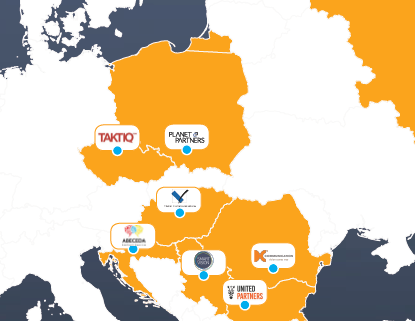Eastern and Central Europe is one of the fastest growing regions in the world in terms of economic, social and cultural development. After decades under communism, the area is experiencing a rapid technological and ideological leap forward which is contributing to the shape of Europe today and its future. All of the countries in the region are considered to be democratic, with free election and free market as the principle.
The citizens of the region are eager to adopt new technologies and ideas and the EMEA region is also often picked as a testing ground for new solutions, such as contactless payment systems and the latest solutions for telecommunication companies. As our report shows, more decision-making units of international corporations are being moved into the region, testament to the faith in the area and its growing importance.
Łukasz Wilczyński | CEO Planet Partners
New solutions and ideas are increasingly being incorporated into the world of marketing and public relations. Observing each market closely, we can notice a major shift not only in terms of customers, where companies are starting to appreciate new tools and solutions, but also in the media, where organic, non-commercial content is becoming marginalized. Social media activities are being pushed into fully paid models, with more traditional media, like newspapers and magazines, following close behind.
This report is the result of cooperation between the agencies and public relations companies which are members of the Eastern European HUB of the GlobalCom PR Network. What we wanted to achieve was to compile data and information about the communication landscape in the region so that corporations planning to move into each market could assess their possibilities and options. The report is also aimed at helping the reader to understand the specifics and nuances of each market, something which will aid managers and decision-making units in choosing the right tools and solutions for their communication efforts in each country.
For a large part of modern history, the countries of Eastern and Central Europe were more or less alienated from their neighbours in the West. Economic and political development was hampered and societies were divided. All of this changed almost 30 years ago with the fall of the Berlin Wall. Countries and their citizens were eager to test and adopt new technologies and international corporations were finally able to explore the opportunities afforded by these new markets.
Many countries in the EMEA region have been chosen by tech solution providers as a testing ground for their new solutions and technology. As a result, one can notice a very high level of adoption of technologies such as contactless payments or digital education systems. As the work force in the region is considered as being cheaper than in Western Europe, more international corporations are becoming engaged in the local economy, with the automotive, fintech and IT outsourcing markets to the fore.
The media landscape in the EMEA region is also changing, with digital media gaining a stronger position on the market – especially among digital natives. Traditional media remain strong; TV, radio and newspapers are still considered among the biggest ad-budget beneficiaries in the market (with Google and Facebook alongside them or even ahead). With the advertisement budget taken by traditional media and Internet giants, websites and portals are becoming more aggressive by pushing a commercial cooperation model, with traditional media relations and press release distribution waning.
Commercial cooperation is becoming increasingly crucial when newspapers or their digital branches are considered as the target media for the campaign. In countries with a highly developed influencer market, organic or barter cooperation with celebrities is also becoming harder to conduct, which leads to less engaged influencers and reduced amounts of relevant content. This is why personalized, exclusive and high-quality content is becoming the key to media relations in the region. Cases of ignoring brand news and product announcements by journalists and influencers are becoming more frequent, as they prefer to receive bespoke-made content created through personal cooperation.
Content marketing and self-owned media are on the rise. As media relations are becoming harder to implement or too expensive for small and medium sized companies, more are investing in blogs and theme or product-dedicated websites. Companies, especially from the e-commerce and lifestyle markets, are funding entire e-ecosystems filled with PR content with a clear goal in mind – to bring converts and customers to their shop or main website. These actions are supported by social media and digital advertising and together they form the core of their PR activities.
This shift in attitude can also be noticed among the brands and customers of communication companies. The results must be driven by relevant data, with KPIs’ like AVE and audience range being discarded from contracts. Instead, results should be reported with numbers and clear indicators taken straight from the marketing world. Public Relations and Marketing are intermingling with one another and brands expect PR specialists to bring the same results as an entire Sales Department – not in the expense tables, but as the source of income.
Eastern and Central Europe markets can be described as fast growing and eager to adopt new technologies and ideas. After many years of stagnation, recent decades have kick-started local economies and societies. The media landscape is changing and traditional methods of influence are becoming less relevant. Brands and customers are also changing and expect a different approach to communication and Public Relations in general, with a strong focus on bringing measurable effects. PR agencies and communication specialists need to answer the needs of the market or their part will become increasingly less important.

